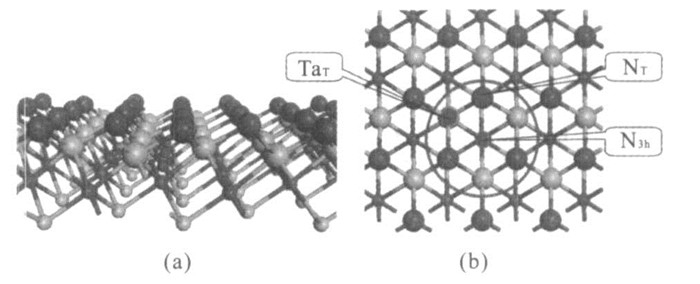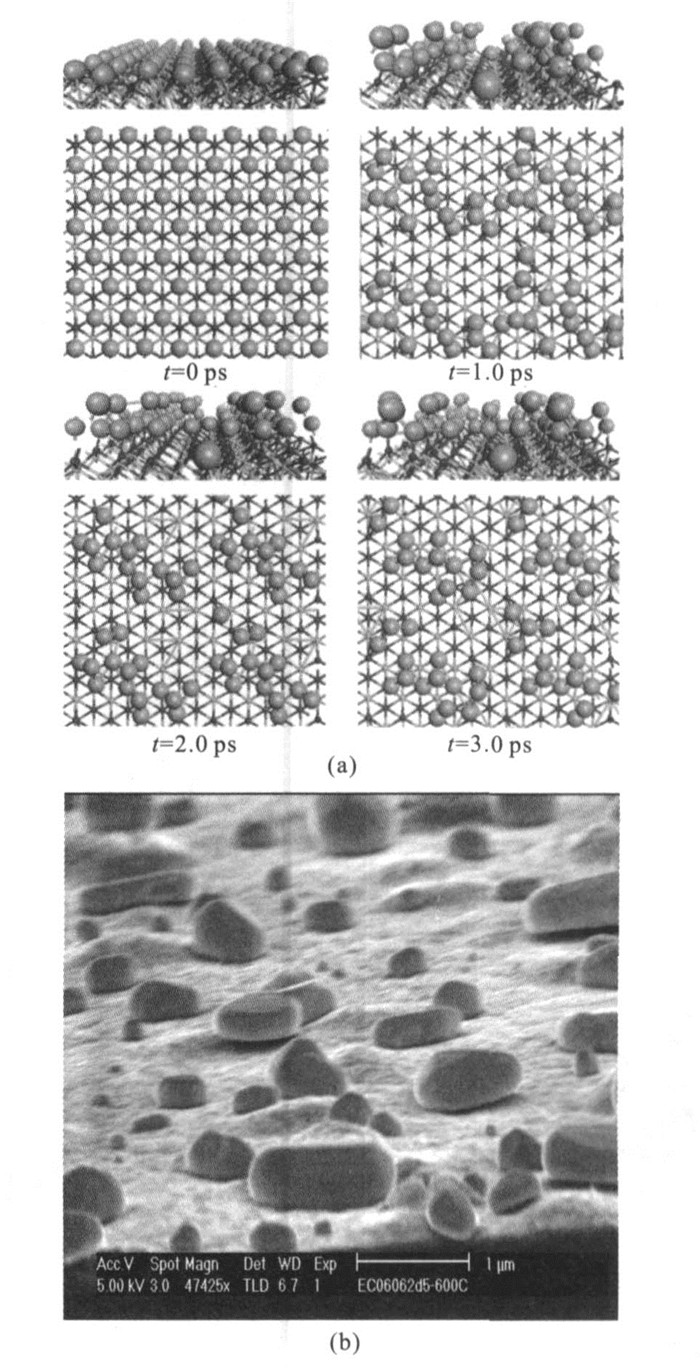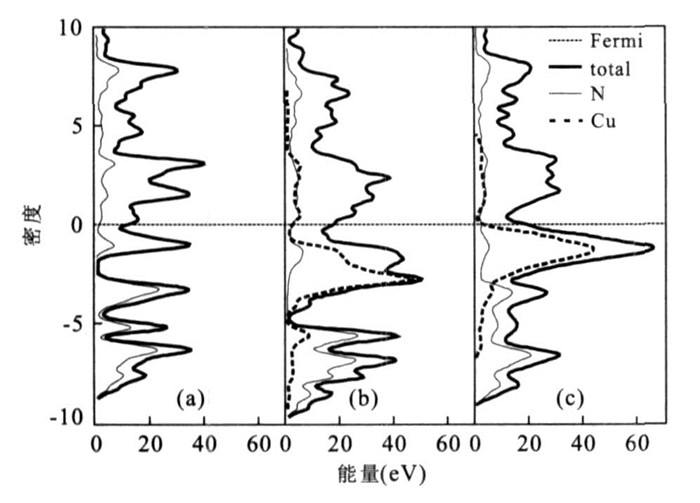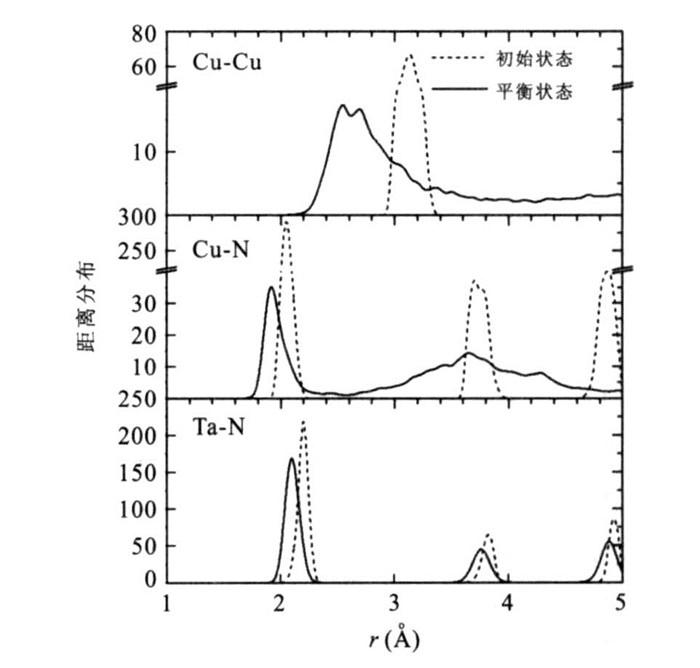A Molecular Dynamics Simulation on the Agglomeration Behavior of Cu on TaN(111) Surface
-
摘要: 原子层沉积(ALD) 是下一代超大规模集成电路的首选工艺, 但是Cu籽晶层在阻挡层上的团聚限制了ALD工艺在半导体工业中的应用.目前对Cu在阻挡层TaN表面的团聚机理和行为还缺乏足够的理论认识, 为此利用第一性原理密度泛函理论(DFT) 对不同覆盖度下Cu原子在TaN (111) 表面的吸附能和电荷转移进行了研究, 结果显示, Cu在TaN (111) 表面的吸附强度随着Cu覆盖度的增加而减弱.利用从头算分子动力学模拟了500K温度下Cu单分子层在TaN (111) 表面的吸附动力学行为, 结果表明, 在这一典型的ALD温度下, Cu层在TaN (111) 表面发生团聚, 与实验中的观察结果相符.Abstract: Cu seed layer agglomeration on barriers is a bottleneck in semiconductor industry for the application of atomic layer deposition (ALD) which is the preferred technology for the next-generation ultra large-scale integrated circuit (ULSC).However, the theoretical understanding of the underlying mechanisms of Cu aggregation is still not clearly known.We made a first-principles study of copper aggregation on the TaN (111) surface, using density functional theory.The adsorption energies and charge transfers were evaluated to address the interactions between Cu and the substrate.Ab initio molecular dynamics simulations were performed to examine the dynamic behavior of a copper monolayer originally commensurate with the TaN substrate at the typical atomic layer deposition (ALD) operating temperature (500 K).The results revealed that the copper film underwent substantial agglomeration on the TaN (111) surface at this ALD operating temperature, which was consistent with experimental observations.
-
Key words:
- agglomeration /
- TaN /
- DFT /
- molecular dynamics /
- semiconductor materials.
-
图 2 分子动力学过程中的几个时间点的结构(a) 和TaN表面Cu团聚形成的孤岛的SEM照片(b) (Zhao et al., 2007)
Fig. 2. Snapshot of the MD trajectory (a) and SEM image of Cu islands on TaN surface (b)
表 1 TaN (111) 表面吸附不同覆盖度的Cu原子的吸附能和电子转移
Table 1. Adsorption energy and electron transfer of copper on TaN (111) surface at different coverage

表 2 TaN (111) 和WN (001) 表面作为不同吸附基底的比较
Table 2. Comparison between TaN (111) and WN (001) substrate

-
Becker, J. S., Gordon, R. G., 2003. Diffusion barrier proper-ties of tungsten nitride fil ms grown by atomic layer dep-osition from bis (tert-butyli mido) bis (di methylamido) tungsten and ammonia. Applied Physics Letters, 82 (14): 2239-2241. doi: 10.1063/1.1565699 Besling, W. F. A., Federspiel, X., Vanypre, T., et al., 2005. Copper alloy seed integration for reliability i mprove-ment. Microelectronic Engineering, 82 (3-4): 254-260. doi: 10.1016/j.mee.2005.07.031 Guvelioglu, G. H., Ma, P., He, X., et al., 2006. First princi-ples studies on the growth of small Cu clusters and thedissociative chemisorption of H2. Physical Review B, 73 (15): 155436-155445. doi: 10.1103/PhysRevB.73.155436 Han, B., Wu, J., Zhou, C., et al., 2008. Ab initio moleculardynamics si mulation on the aggregation of a Cu mono-layer on a WN (001) surface. Journal of PhysicalChemistry C, 112 (26): 9798-9802. Inberg, A., Shacham-Diamand, Y., Rabinovich, E., et al., 2001. Material and electrical properties of electrolessAg-Wthin fil m. J. Electron. Mater., 30 (4): 355-359. doi: 10.1007/s11664-001-0043-x Jackson, R. L., Broadbent, E., Cacouris, T., et al., 1998. Processing andintegration of copper interconnects. Sol-id State Technology, 41 (33): 49-59. Kaloyeros, A. E., Eisenbraun, E., 2000. Ultrathin diffusionbarriers/liners for gigascale copper metallization. Annu-al Reviewof Materials Science, 30 (1): 363-385. doi: 10.1146/annurev.matsci.30.1.363 Kim, H., Koseki, T., Ohba, T., et al., 2006. Effect of Rucrystal orientation on the adhesion characteristics of Cufor ultra-large scale integration interconnects. AppliedSurface Science, 252 (11): 3938-3942. Kleinman, L., Bylander, D. M., 1982. Efficacious form formodel pseudopotentials. Physical Review Letters, 48 (20): 1425-1428. doi: 10.1103/PhysRevLett.48.1425 Kohn, W., 1999. Nobel lecture: Electronic structure of mat-ter-wave functions and density functionals. Reviews ofModern Physics, 71 (5): 1253-1266. Li, B. Z., Sullivan, T. D., Lee, T. C., et al., 2004. Re liability challenges for copper interconnects. Microelectronics Reliability, 44 (3): 365-380. doi: 10.1016/j.microrel.2003.11.004 Li, Z., Gordon, R. G., Farmer, D. B., et al., 2005. Nucleationand adhesion of ALD copper on cobalt adhesion layersand tungsten nitride diffusion barriers. Electrochemica land Solid-State Letters, 8 (7): G182-G185. doi: 10.1149/1.1924929 Liu, H. T., Wu, Z. Q., 2001. Some issues of the materialphysics for ultra-large-scale integration-Cu interconnect & metallization (Ⅰ). Physics, 30 (12): 757-761 (inChinese with English abstract). Machado, E., Kaczmarski, M., Ordejón, P., et al., 2005. First-principles analyses and predictions on the reactivi-ty of barrier layers of Ta and TaNtoward organometal-lic precursors for deposition of copper fil ms. Langmuir, 21 (16): 7608-7614. doi: 10.1021/la050164z Murarka, S. P., Gut mann, R. J., Kaloyeros, A. E., et al., 1993. Advanced multilayer metallization schemes withcopper as interconnection metal. Thin Solid Fil ms, 236 (1-2): 257-266. doi: 10.1016/0040-6090(93)90680-N Nicolet, M. A., 1978. Diffusion barriers in thin fil ms. ThinSolid Fil ms, 52 (3): 415-443. Perdew, J. P., Burke, K., Ernzerhof, M., 1996. Generalizedgradient approxi mation made si mple. Physical ReviewLetters, 77 (18): 3865-3868. doi: 10.1103/PhysRevLett.77.3865 Perdew, J. P., Wang, Y., 1992. Accurate and si mple analytic representation of the electron-gas correlation energy. Physical Review B, 45 (23): 13244-13249. doi: 10.1103/PhysRevB.45.13244 Rosenberg, R., Edelstein, D. C., Hu, C. K., et al., 2000. Copper metallization for high performance silicon tech-nology. Annual Reviewof Materials Science, 30: 229-262. doi: 10.1146/annurev.matsci.30.1.229 Sai-Halasz, G., 1995. Performance trends in high-end proces-sors. Proceedings of the IEEE, 83 (1): 20-36. doi: 10.1109/5.362754 Soler, J. M., Artacho, E., Gale, J. D., et al., 2002. The SIES-TA method for ab initio order-N materials si mulation. Journal of Physics: Condensed Matter, 14 (11): 2745-2779. doi: 10.1088/0953-8984/14/11/302 Torres, J., 1995. Advanced copper interconnections for sili-con CMOS technologies. Applied Surface Science, 91 (1-4): 112-123. doi: 10.1016/0169-4332(95)00105-0 Troullier, N., Martins, J. L., 1991. Efficient pseudopotentialsfor plane-wave calculations. Physical Review B, 43 (3): 1993-2006. doi: 10.1103/PhysRevB.43.1993 Wu, J. P., Han, B., Zhou, C., et al., 2007. Density functiontheory study of copper agglomeration on the WN (001) surface. Journal of Physical Chemistry C, 111 (26): 9403-9406. doi: 10.1021/jp072907q Zhang, W. J., Yi, W. B., Wu, J., 2006. Electromigrationin Alinterconnects and the challenges in ultra-deep submi-cron technology. Acta Physica Sinica, 55 (10): 5424-5434 (in Chinese with English abstract). doi: 10.7498/aps.55.5424 Zhao, C., T kei, Z., Haider, A., et al., 2007. Failure mecha-nisms of PVD Ta and ALD TaN barrier layers for Cucontact applications. Microelectronic Engineering, 84 (11): 2669-2674. doi: 10.1016/j.mee.2007.05.061 刘洪图, 吴自勤, 2001. 超大规模集成电路的一些材料物理问题(Ⅰ)——Cu互连和金属化. 物理, 30 (12): 757-761. doi: 10.3321/j.issn:0379-4148.2001.12.005 张文杰, 易万兵, 吴瑾, 2006. 铝互连线的电迁移问题及超深亚微米技术下的挑战. 物理学报, 55 (10): 5424-5434. https://www.cnki.com.cn/Article/CJFDTOTAL-WLXB200610073.htm -










 下载:
下载:




